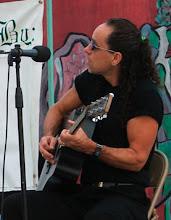WORKSHOP: Found Instruments & Body/Vocal Percussion
HELLO! My name is David McLean, and I’m your instructor today. This handout is what you will receive at our "Found Instruments & Body/Vocal Percussion" workshops.
Let’s quickly cover a few items….
I: Tempo, Rhythm, & Meter
“Tempo” just means the speed at which you are playing. While some music varies in tempo or is played without a definitive tempo, the vast majority (especially for groups of people), a tempo is not only present, but a required element. It is the musical glue that holds everything (and everyone) together.
“Rhythm” is just pattern of sound - a cyclic pattern in time that you play over and over again (with variation) throughout a piece or a section of music. It's the “timing of events” as we listen and play.
“Meter” is, to somewhat over-simplify for the purposes of this workshop, the next level of “pattern”, as it arranges the rhythm into a larger coherent pattern of measures (bars). Time signatures such as 3/4 and 4/4 and 6/8 are what we are currently referring to when using the term meter.
II: Types of Percussion
There are various ways to categorize percussion instruments (by region, by function, by sound production, etc), but our main focus today is on conventional vs un-conventional (or traditional vs non-traditional).
Percussion, aside from the human voice itself, is doubtless the oldest of human instruments, and some form of percussion exists in every culture known to man, and in every culture in human history.
From clacking rocks to body percussion, banging sticks to vocal percussion, rhythm playing is woven into the fabric of all human beings.
Let’s look at a few types of percussion as well as conventional and un-conventional examples of each. This should give you plenty of ideas to exercise this concept on your musical journey.
Idiophones are instruments that produce sound via the instrument body itself vibrating. To over-simplify for our purposes, think primarily of instruments/items that are knocked or scraped together (conventional: wood blocks, rattles & shakers, clapsticks…un-conventional: spoons, various bells, brooms…)
Membranophones are instruments that produce sound when a membrane - or “head” - is struck with a mallet or hand. Conventional: snare drums, tablas, bongos…un-conventional: fixed springs, plastic bag & bucket drum….
Chordophones are instruments that use vibrating strings as sound generation, like pianos and guitars and such. We’ll sidestep this particular classification for the moment.
Aerophones are instruments that require airflow. Examples include Apito, slide whistle, etc (conventional) as well as standard police whistles, sirens, etc (un-conventional).
Historical examples of body and vocal percussion would include Indonesian “saman”, the claps & finger-snaps in Flamenco music, and the “hambone” of the American south; Konnakol of southern India & tabla “bols” of northern India, the beatboxing of hip-hop music, and the “eefing” of Appalachia. Techniques include clapping/slapping, finger snapping, foot stomping, and such (body percussion), as well as rhythmic breathing, hard consonants, mechanical mimicry, and the like.
We can also ponder the nature of both melodic (or “definite pitch”) percussion and non-melodic (or “indefinite pitch”) percussion. Examples of the former include marimba and steel pan, while examples of the latter include cymbal and rainstick.
Un-conventional “found” percussion in modern western music (think of the last 100 years or so), has been used in classical music (from actual cannons to paperclips, to the altering of traditional instruments like John Cage’s “prepared piano”) as well as folk musics (like the washboards and washtub bass and rhythm bones of the early 20th century jug bands).
Acts utilizing these un-conventional instruments range from popular acts occasionally adding such instruments (among the most popular examples would be Aerosmith, who used a whip, a shotgun, and a sugar packet as a shaker in songs like “Sweet Emotion” and “Train Kept a-Rollin’”) to artists making much large use of found & body percussion (Grammy winning jazz artist Bobby McFerrin comes immediately to mind), performing ensembles who almost exclusively use found objects & home-made percussion (such as Blue Man Group’s PVC drums and the performance troupe STOMP, who use everything from brooms to playing card to pocket change in addition to vocal & body percussion).
Ultimately, all the same principles of tempo and rhythm and meter still apply, so whether you’re playing alone for fun, with a drum circle, or some other ensemble scenario, allow those principles to hopscotch from one instrument to the other and you’ll find yourself quickly acclimating to any percussion instrument.
III: Conclusion
I hope your experience at today’s workshop was educational and entertaining! Please continue your journey by playing along with pre-recorded music, regularly attending (or hosting) a local drum circle, or joining & performing with a community percussion ensemble.
And, of course, be sure to look out for other percussion and music workshops, explore the possibility of regular lessons, and explore all the online resources available in both text and video formats!
====
Monthly support: https://www.patreon.com/skinnydevilmusic or https://www.paypal.me/skinnydevilmusic (Pay What You Will)
One-shot support: https://www.paypal.me/skinnydevilmusic or www.venmo.com/David-McLean-47 (Pay What You Will)





No comments:
Post a Comment